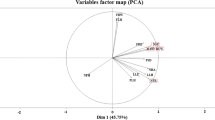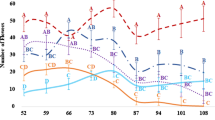Abstract
The objective of this study was to agronomically characterize plants from induced chromosome doubling experiments in the Pisang Lilin parthenocarpic banana accession to select genotypes that will be used as 2n gamete donors in crosses with improved diploids to generate secondary triploids. Twenty-two plants were evaluated, of which 17 were autotetraploids. Compared with the original diploids, the Pisang Lilin autotetraploids showed significant increases in the plant height, number of living leaves at flowering and harvest, pseudostem diameter, and length and diameter of fruits; the Pisang Lilin autotetraploids also exhibited greater fruit and bunch weights compared with the original diploids. In addition, all autotetraploid plants did not exhibit any symptoms of yellow Sigatoka. Female fertility was also detected, as some plants produced seeds, indicating that they can be used as female parents. Therefore, the autotetraploids characterized in this study exhibited useful agronomical traits to be used as 2n gamete donors for generating secondary triploids.



Similar content being viewed by others
References
Bakry F, Reberdiere NP, Pichot S, Jenny C (2007) In liquid medium colchicine treatment induces non chimerical doubled-diploids in a wide range of mono-and interspecific diploid banana clones. Fruits 62:3–12
Carvajal SLB (1991) El cultivo del plátano en el trópico [Banana cultivation in the tropics]. Impressora Feriva, Cali
Costa FHS, Pasqual M, Silva SO, Neto HPS, Amorim EP, Santos-Serejo JA (2011) Polyploidization in banana shoot apex and its morphophysiological effects in vitro. Pesqui Agropecu Bras 46:805–813
Daniells J, Jenny C, Karamura D, Tomekpe K (2001) Williams, cultivated varieties AAA. In: Sharrock S (ed) Musalogue: a catalogue of Musa germplasm – diversity in the genus Musa. INIBAP, Montpellier, p 76
Dodds KS (1943) Genetic and cytological studies of Musa. V. Certain edible diploids. J Genet 45:113–138
Dunn LB, Lindstrom JT (2007) Oryzaline-induced chromosome doubling in Buddleja to facilitate interspecific hybridization. HortScience 42:1326–1328
Elliott F (1967) Mejoramiento de plantas - citogenética [Plant breeding—cytogenetics]. Compañia Editorial Continental, Mexico
Food and Agriculture Organization of the United Nations (2013) Production (2011). http://faostat.fao.org/site/567/default.aspx#ancor. Accessed 6 Feb 2013
Ganga M, Chezhiyan N (2002) Influence of the antimitotic agents colchicine and oryzalin on in vitro regeneration and chromosome doubling of diploid bananas (Musa spp.). J Hortic Sci Biotechnol 77:572–575
Gauhl F (1994) Epidemiology and ecology of black sigatoka (Mycosphaerella fijiensis Morelet) on plantain and banana (Musa spp.) in Costa Rica, Central America. INIBAP, Montpellier
Guo M, Davis D, Birchler JA (1996) Dosage effects on gene expression in a maize ploidy series. Genetics 142:1349–1355
Hamill SD, Smith MK, Dodd WA (1992) In vitro induction of banana autotetraploids by colchicine treatment of micropropagated diploids. Aust J Bot 40:887–896
Institute SAS (2010) SAS/STAT: user´s guide statistics: 9.2. SAS Institute, Cary
Kanchanapoom K, Koarapatchaikul K (2012) In vitro induction of tetraploid plants from callus cultures of diploid bananas (Musa acuminata, AA group) ‘Kluai Leb Mu Nang’ and ‘Kluai Sa’. Euphytica 183:111–117
Lu C, Bridgen MP (1997) Chromosome doubling and fertility study of Alstroemeria aurea x A. caryophyllaea. Euphytyca 94:75–81
Murashige T, Skoog FA (1962) A revised medium for rapid growth and bioassays with tobacco tissue culture. Physiol Plant 15:473–497
Nimura M, Kato J, Horaguchi H, Mii M, Sakai K, Katoh T (2006) Induction of fertile amphidiploids by artificial chromosome-doubling in interspecific hybrid between Dianthus L and D. japonicas Thunb. Breed Sci 56:303–310
Pio LAS, Morais Lino LS, Oliveira ACL, Silva SO, Pasqual M, Asmar AS (2010) Técnica de pré-seleção em diploides de bananeira submetidas à duplicação de cromossomos [Pre-selection technique for banana diploids subjected to chromosome doubling]. In: Congresso Brasileiro de Fruticultura [Brazilian Congress of Fruit Crops]. Sociedade Brasileira de Fruticultura, Natal. http://ainfo.cnptia.embrapa.br/digital/bitstream/item/36004/1/ID27114pdf710.pdf. Accessed 29 Jan 2013
Predieri S (2001) Mutation induction and tissue culture in improving fruits. Plant Cell Tissue Organ Cult 64:185–210
Raboin LM, Carreel F, Noyer JL, Baurens FC, Horry JP, Bakry F, Tèzenas Du, Montcel H, Ganry J, Lanaud C, Lagoda PJL (2005) Diploid ancestors of triploid export banana cultivars: molecular identification of 2n restitution gamete donors and n gamete donors. Mol Breed 16:333–341
Rhee HK, Cho HR, Kim KJ, Kim KS (2005) Comparison of pollen morphology in interspecific hybrid lilies after in vitro chromosome doubling. Acta Hortic 673:639–643
Sanford JC (1983) Ploidy manipulations. In: Moore JN, Janick J (eds) Methods in fruit breeding. Purdue University Press, West Lafayette, pp 100–123
Shepherd K (1987) Banana breeding, past and present. Acta Hortic 196:37–43
Shepherd K, Dantas JLL, Alves EJ (1987) Banana breeding in Brazil. In: Persley GJ, De Langhe EA (eds) Banana and plantain breeding strategies. Australian Center for International Agricultural Research, Canberra, pp 78–83
Silva SO, Matos AP, Alves EJ (1998) Genetic improvement of banana tree. Pesqui Agropecu Bras 33:693–703
Silva SO, Souza-Junior MT, Alves EJ, Silveira JRS, Lima MB (2001) Banana breeding program at Embrapa. Crop Breed Appl Biotechnol 1:399–436
Silva SO, Flores JCO, Lima Neto FP (2002) Evaluation of banana cultivars and hybrids in four production cycles. Pesqui Agropecu Bras 37:1567–1574
Silva SO, Passos AR, Donato SLR, Salomão LCC, Pereira LV, Rodrigues MGV, Lima Neto FP, Lima MB (2003) Evaluation of banana genotypes in different environments. Ciênc Agrotec 27:737–748
Simmonds NW (1995) Bananas. In: Smartt J, Simmonds NW (eds) Evolution of crop plants. Longman Scientific & Technical, Essex, pp 370–374
Soto Ballestero M (1992) Bananos: cultivo y comercialización [Bananas: cultivation and commercialization], 2nd edn. Litografia e Imprensa, San José
Stover RH (1971) A proposed international scale for estimating intensity of banana leaf spot (Mycosphaerella musicola). Trop Agric 41:185–196
Stover RH, Buddenhagen IW (1986) Banana breeding: polyploidy, disease resistance and productivity. Fruits 41:175–191
Tesfaye M (2005) Agronomic and yield performance of induced-autotetraploid ensete (Ensete ventricosum) clones. Plant Genet Resour Newsl 143:56–58
Vakili NG (1967) The experimental formation of polyploidy and its effect in the genus Musa. Am J Bot 54:24–36
Van Duren M, Morpurgo R, Dolezel J, Afza R (1996) Induction and verification of autotetraploids in diploid banana (Musa acuminata) by in vitro techniques. Euphytica 88:25–34
Wan Y, Petolino JF, Widholm JM (1989) Efficient production of doubled haploid plants through colchicine treatment of anther-derived maize callus. Theor Appl Genet 77:889–892
Yu CY, Kim HS, Rayburn AL, Widholm JM, Juvik JA (2009) Chromosome doubling of the bioenergy crop, Miscanthus × giganteus. GCG Bioenergy 1:404–412
Author information
Authors and Affiliations
Corresponding author
Rights and permissions
About this article
Cite this article
do Amaral, C.M., de Almeida dos Santos-Serejo, J., de Oliveira e Silva, S. et al. Agronomic characterization of autotetraploid banana plants derived from ‘Pisang Lilin’ (AA) obtained through chromosome doubling. Euphytica 202, 435–443 (2015). https://doi.org/10.1007/s10681-014-1320-0
Received:
Accepted:
Published:
Issue Date:
DOI: https://doi.org/10.1007/s10681-014-1320-0




